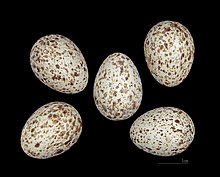|
Thekla's lark
Thekla's lark (Galerida theklae), also known as the Thekla lark, is a species of lark that breeds on the Iberian Peninsula, in northern Africa, and sub-Saharan Africa from Senegal to Somalia. It is a sedentary (non-migratory) species. This is a common bird of dry open country, often at some altitude. Thekla's lark was named by Alfred Edmund Brehm in 1857 for his recently deceased sister Thekla Brehm (1833–1857). The name is a modern Greek one, Θέκλα (Thekla), which comes from ancient Greek Θεόκλεια (Theokleia) derived from θεός (theos, "god") and κλέος (kleos, "glory" or "honour").[2] The population is declining in Spain, but this is a common bird with a very wide range and the International Union for Conservation of Nature has rated its conservation status as being of "least concern".[1] Taxonomy and systematicsThekla's lark has several East African subspecies that show deep genetic divergence both among themselves and from the Mediterranean populations and are consequently strong candidates for consideration as separate species.[3] Formerly, some authorities considered Thekla's lark and the Malabar lark to be conspecific. Alternate names for Thekla's lark include short-crested lark and Thekla crested-lark.[4] SubspeciesTwelve subspecies are recognized:[5]
DescriptionThis is a smallish lark, slightly smaller than the Eurasian skylark. It has a long, spiky, erectile crest. It is greyer than the Eurasian skylark, and lacks the white wing and tail edge of that species. It is very similar to the widespread crested lark. It is smaller and somewhat greyer than that species, and has a shorter bill. In flight, it shows grey underwings, whereas the crested lark has reddish underwings. The body is mainly dark-streaked grey above and whitish below. The sexes are similar.[6] Distribution and habitatThekla's lark is native and resident in France, Spain, Portugal, Algeria, Egypt, Eritrea, Ethiopia, Kenya, Libya, Morocco, Somalia, Tunisia and Western Sahara.[1] Its typical habitat is rugged areas with scrub, bare patches of ground and semi-arid grassland.[7] Behaviour and ecology It nests on the ground, laying two to six eggs. Its food is weed, seeds and insects, the latter especially in the breeding season.[7] The song is melodious and varied, with mournful whistles and mimicry included. It is softer and more tuneful than that of the crested lark, and may be sung during flight or from the ground or an exposed perch.[6] References
External linksWikimedia Commons has media related to Galerida theklae. Wikispecies has information related to Galerida theklae. |
||||||||||||||||||||||||||||||||||||||||||
Portal di Ensiklopedia Dunia




